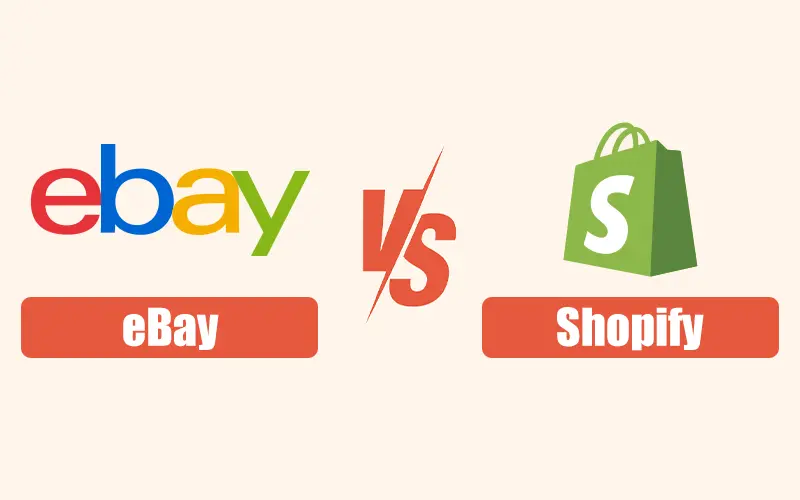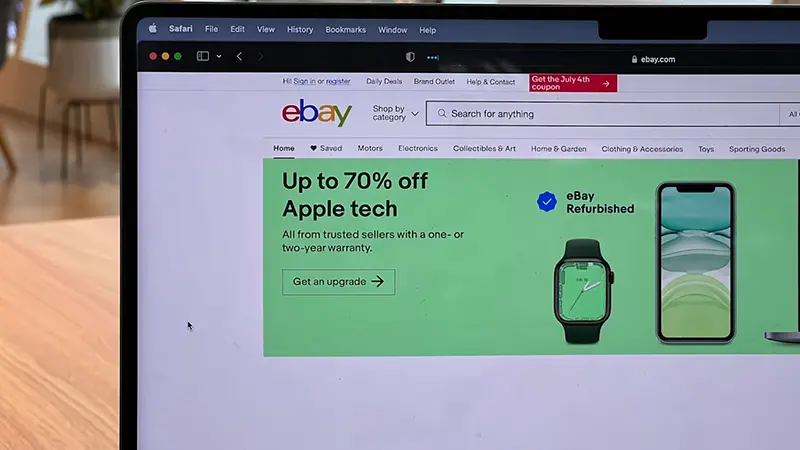Selecting the right selling platform can make a huge difference when it comes to dropshipping and online retailing business. Here, we will discuss dropshipping eBay vs Shopify, both of which are powerful in their own right. These platforms differ in many aspects – customer base, competition, branding, customization, and more.
In this guide, we’ll compare the strengths and weaknesses of each platform. This helps you understand which one will be suitable for your needs and helps you achieve the desired outcomes. So, let’s compare dropshipping on eBay vs Shopify to help you find the perfect platform!

Dropshipping eBay vs. Shopify: Overview of the Platforms
When speaking of dropshipping as a long-term business strategy, it is important to learn the particularities of each platform. In a way, both eBay and Shopify have a different take on the concept of dropshipping, addressing different requirements of sellers. The following is a comparison of the performance of each platform.
eBay Dropshipping
eBay is a rather popular and long-time online marketplace whose audience base consists of millions of users worldwide. This large customer base is one of eBay’s main advantages because new dropshippers don’t need to work hard on advertising.
Secondly, when engaged in eBay dropshipping, you don’t keep an inventory but sell the products from suppliers in your eBay shop. Nonetheless, eBay has measures that direct to the dropshippers. Pertinently, sellers cannot directly order products from other retailers or platforms like Amazon or Walmart. This constraints the pool where you can buy inventories from.
Furthermore, your identifiers must be displayed on the packing slip, the invoice, and any external packing. Make sure your supplier adheres to these conditions to ensure you can sell on eBay.
Shopify Dropshipping
Unlike eBay, Shopify is an eCommerce platform which means you won’t be selling anything through a marketplace. Instead, you’ll be selling on an online store you build with the platform. Shopify’s dropshipping model gives users better control over its brand — from building websites to managing customer experience. Shopify provides dropshippers a way to link their stores to famous dropshipping apps, such as EPROLO, to add products and automatically fulfill orders.
The biggest advantage of Shopify dropshipping is that you can start your own brand. It allows sellers to build a very customized, branded shopping experience that helps establish trust and builds loyalty with consumers. However, Shopify differs from eBay since it doesn’t have an in-built audience. So, Shopify sellers need a lot of marketing efforts to get visitors, as is the case with any standalone store.
eBay vs. Shopify: Key Differences
Each platform has its own unique set of features. By comparing these differences, you can choose which one is the ideal fit for your business. It comes down to the goals you want to achieve, your branding preferences, and how you want your customers to experience purchasing from you. Let’s take a close look at some key differences.
Ease of Setup
eBay and Shopify setup processes cater to both new and experienced users but in slightly different ways depending on the stage of the account.
It’s simple to start a business on eBay with dropshipping. eBay marketplace format means that each seller has a common storefront under eBay’s brand. This reduces the need for extensive customization during setup. So, sellers only have to create an account, fill in personal or business information, and list products.
Although eBay limits branding opportunities as sellers can’t build a unique, independent identity. However, since eBay doesn’t require you to pay for setup or do web design, you can begin to list and sell products instantly. All in all, eBay setup is faster and easier, but it is also less complex and grants you less control over what your store looks like and does.
For a start, Shopify has a completely customizable setup experience. Users sign up for a free account and fill out the contextual information about themselves to build their online business. And then they get tools to create a decently good branded website. For those planning to start a distinct brand dropshipping journey, Shopify’s platform offers a unique look and feel for your store. This is why it makes the ideal choice for those looking for high customization.
Once they’ve designed, sellers choose between Shopify Payments (no transaction fees) or a third party option (which might have additional fees). The platform is especially beneficial for long-term brands trying to build customer loyalty and a strong brand image.

Customization & Customer Experience
The customization options and overall customer experience you provide can make all the difference for your brand’s image and customer satisfaction.
We already know that eBay provides limited customization options, being a marketplace with the same structure layout for all sellers. You can add minimal branding elements such as a logo, to help differentiate your store from the rest of eBay’s. However, these are the extent of customization options available.
The same goes for the eBay checkout experience. It is standardized, giving customers a familiar experience without allowing sellers to personalize the journey. Familiarity with the platform can bring trust, as customers know the platform, but also limits the possibility for sellers branding. It works well for many as eBay’s approach is simple. But for brands that want to provide unique, memorable customer experiences, it may not be enough.
Sellers can customize their entire site to their liking on Shopify. Users are given a number of free themes to choose from, color and font customization options. They also have the ability to slowly work their way into custom coding with custom design elements. If you are an advanced user with coding ability, you can create a highly personalized, unique online store.
From the landing page to the checkout, with Shopify, the customer journey and consistency of branding never ends. Sellers can design checkout, add banners, and tweak site layout to create a cohesive and engaging purchasing experience.
Opportunities in Marketing & Branding
Good marketing and branding matters a lot. It directly impacts how much you generate from your dropshipping business and how you reach your target audience. Here are some things to consider:
Email Marketing:
eBay does not give sellers direct access to customer email addresses, restricting options for email marketing. All you get on eBay is a couple of basic templates, so sellers do not have much creative content and personalization control in customer outreach.
On the other hand, Shopify provides full control over email marketing. You’re allowed to collect and store emails via Mailchimp or other integrations such as Klaviyo. By having access to visitor’s emails, Shopify sellers can send customized newsletters, promotional emails, and abandoned cart reminders to customers. This helps in building deeper customer relationships and gaining loyalty.
Content Marketing
As an eBay seller, content marketing can be difficult since the platform doesn’t have native blogging capabilities. If you want to be in the content marketing game, you’ll need to have a blog on an external platform. And when the blog posts link back to your eBay listings, you start to generate organic traffic.
Shopify offers a built-in blogging feature which makes it much easier for sellers to integrate content marketing into their website. Shopify can publish blog posts to generate traffic, educate customers, and improve SEO, all in one space.
SEO:
The presence of eBay on search engines eBay and Google gives eBay sellers an advantage in the market. Listing your products on eBay helps improve search reach as it doubles the channels your products can appear on. Ranking on two search engines gives you an impressive amount of organic visibility, reaching more potential customers. But sellers actually don’t have much control over their eBay SEO strategies outside of their product listings.
Shopify’s SEO capabilities are more powerful. Shopify store owners can optimize your product pages, meta descriptions, and blog posts for Google ranking. On top of this, Shopify allows you to integrate with SEO apps to further boost a store’s search performance.

Payment Processing
Payment processing options on both platforms vary, influencing transaction flexibility and fees.
eBay provides limited payment options, often defaulting to PayPal, which is widely recognized and convenient for users but restricts variety. Buyers can also use credit cards, but payment options are otherwise limited.
On the other hand, Shopify offers a built-in payment solution, Shopify Payments. This option has no transaction fees, which simplifies the payment process for sellers. Shopify also supports numerous third-party payment providers, though additional fees may apply. This flexibility allows Shopify sellers to cater to a broader audience with diverse payment preferences.
Pricing
The fee structure on each platform is different, which affects the profit margins and cost-effectiveness.
If sellers choose to have an eBay Store, eBay’s pricing includes subscription plans, insertion fees, and final value fees. Let’s go with eBay’s five subscription options first:
- Starter Store – $7.95 per month or $4.95/month billed yearly
- Basic Store – $27.95 per month or $21.95/month billed yearly
- Premium Store – $74.95 per month or $59.95/month billed yearly
- Anchor Store – $349.95 per month or $299.95/month billed yearly
- Enterprise Store – $2999.95 yearly
The insertion fee is applied to listed products. If you list more than the free listing number of your subscription plan, you need to pay for the additional ones. For final value fees, a percentage of the total amount of the sale that is charged by eBay when you sell. If you don’t calculate these fees precisely, your profit margins will be negatively affected when adding up.
Shopify’s pricing structure primarily involves subscription plans, with different levels depending on the desired features and scaling needs. Let’s see Shopify’s subscription options:
- Shopify Starter – $5 per month
- Shopify Basic – $39 per month or $29/month billed yearly
- Shopify – $105 per month or $79/month billed yearly
- Shopify Advanced – $399 per month or $299/month billed yearly
- Shopify Plus – starts at $2300 per month
Additional costs include dropshipping app fees, supplier fees, and shipping costs. Shopify has fewer incremental charges than eBay, but ongoing costs can vary widely depending on tools and integration.

Shipping Options
Shipping options and support can greatly affect the logistics of a dropshipping business.
eBay supports multiple shipping options, including domestic and international shipping through its Global Shipping Program. This feature allows sellers to reach international customers. eBay manages part of the shipping process, which can reduce complications for sellers unfamiliar with international shipping.
Shopify also offers various shipping options, from discounted rates on major carriers to Shopify Fulfillment Network. This service helps sellers manage storage and shipping logistics. Additionally, sellers can integrate with third-party fulfillment services, allowing them to choose the most efficient solution for their needs.
Apps & Integration
App and integration access can drastically enhance the functionality of the dropshipping store, letting the sellers add more functions that remove operational bottlenecks.
eBay is mainly focused on core functions such as listing products, managing inventory, and fulfillment of orders. eBay’s app integrations are also limited. You have less flexibility with eBay third-party apps and fewer options.
Shopify’s App Store offers an array of dropshipping apps, from sourcing products to order fulfillment. Other advanced features, design elements, and marketing tools also help sellers customize their stores. These apps make Shopify sellers cater to their audience in a better way. Unlike eBay, Shopify’s integration options afford an opportunity to greatly expand the functionality of the business and build it according to personal specifications.
Customer Support
When issues arise, both platforms offer customer support, though with varying levels of accessibility and effectiveness.
eBay has a comprehensive help center and support channels, including email and phone support for seller inquiries. However, sellers have noted that responses can sometimes be slower, especially during peak times.
Shopify offers 24/7 customer support via live chat, email, and phone, providing sellers with timely assistance. Shopify’s customer support is widely regarded as reliable and responsive, with a focus on helping businesses thrive.

Elevate Your Dropshipping Experience with EPROLO
EPROLO is an all-in-one eCommerce solution, specializing in dropshipping. It takes away the complexity of sourcing a product, fulfilling orders, and managing inventory. It integrates with major eCommerce marketplaces, offering an easy-to-use interface, a large product library, and automation.

- Seamless Integration: EPROLO beautifully works with popular eCommerce platforms including Shopify and eBay. This makes it very easy to manage products, orders, and fulfillment in one place.
- User-Friendly Interface and Design: EPROLO features an intuitive and easy-to-use interface that makes it simple for newbies and veterans to get around. It also mitigates a lot of the complexity that would be present in daily operations.
- Extensive Product Library with Easy Search Options: The platform’s extensive library allows sellers to quickly find, filter, and source products across multiple categories. This helps them build a catalog that aligns with their brand and customer preferences.
- Real-Time Inventory Management: EPROLO’s inventory management feature tracks stock levels in real-time, providing timely updates and alerts to avoid stockouts.
- Advanced Automation Tools: EPROLO offers automation for order processing, shipping updates, and even branded packaging options. It enables a hands-off approach and allows dropshippers to focus on growth and customer engagement.
Dropshipping eBay vs. Shopify: Summary
Choose eBay if you’re looking for a platform with low entry barriers, ideal for small to medium-sized stores. With eBay, you can dive right into selling without the need to manage complex branding or design features. This makes eBay a suitable option for beginners or those wanting to experiment in eCommerce without heavy commitments. eBay’s built-in audience and streamlined setup allow sellers to quickly start selling and reach buyers. This is ideal for those focusing on sales volume over brand development.
If you’re considering creating and growing a branded store of your own, go for Shopify. Shopify gives you complete freedom in customization so that you can have full control over your store’s branding and layout. Integrated marketing tools, advanced eCommerce features, and a huge app ecosystem combined with Shopify arm businesses to scale up efficiently. For sellers who want to create a unique shopping experience, Shopify’s app store and integration are available to grow their business.
eBay vs Shopify: FAQs
1. Should you dropship on Shopify or on eBay?
It depends entirely on your business goals. If it’s full control over your branding, store design, and scalability that you want then Shopify is for you, if you want to sell quickly with minimal setup and less branding concern eBay is right for you.
2. Can I sell on both eBay and Shopify?
Of course, a lot of sellers work on both platforms. With eBay integrated with Shopify, it’s possible to sync inventory, manage orders, and reach out to multiple channels. With this, you get access to eBay’s audience and can take advantage of Shopify’s customization and eCommerce tools.
3. Which is more profitable to dropship on, Shopify vs eBay?
The seller’s strategy will vary in profitability. The significantly lower startup costs of eBay compared to Shopify can offer greater control over pricing, branding, and the customer experience, but at the cost of higher levels of competition.
4. What are the risks of dropshipping on eBay vs. Shopify?
Risks include dealing with lots of competition and strict policies found on eBay. By comparison, Shopify gives more control and requires you to make an additional upfront investment in design, marketing, and operations maintenance. The prospects of strong customer service are needed in order to handle returns and disputes for both platforms.







